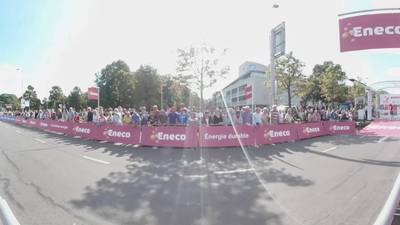Ervaar zelf wat een toprenner allemaal meemaakt tijdens de Eneco Tour-etappe in Brabant en bekijk deze unieke 360˚-aftermovie, www.brabant.nl/360eneco.Voel je zoals Tom Dumoulin, Peter Sagan en Greg van Avermaet.
YOUTUBE

With this article, we aim to increase our understanding of how mobile virtual reality exposure therapy (VRET) can help reduce speaking anxiety. Using the results of a longitudinal study, we examined the effect of a new VRET strategy (Public Speech Trainer, PST), that incorporates 360° live recorded VR environments, on the reduction of public speaking anxiety. The PST was developed as a 360° smartphone application for a VR head-mounted device that participants could use at home. Realistic anxiety experiences were created by means of live 360° video recordings of a lecture hall containing three training sessions based on graded exposure framework; empty classroom (a) and with a small (b) and large audience (c). Thirty-five students participated in all sessions using PST. Anxiety levels were measured before and after each session over a period of 4 weeks. As expected, speaking anxiety significantly decreased after the completion of all PST sessions, and the decrement was the strongest in participants with initially high speaking anxiety baseline levels. Results also revealed that participants with moderate and high speaking anxiety baseline level differ in the anxiety state pattern over time. Conclusively and in line with habituation theory, the results supported the notion that VRET is more effective when aimed at reducing high-state anxiety levels. Further implications for future research and improvement of current VRET strategies are discussed.
DOCUMENT
The current study investigated the relationship between the point-of-view (POV) of a 360-degree film for Head Mounted Displays and the level of presence and enjoyment. We created two conditions with a 360-degree movie, with different POVs (actor and observer). Participants from the actor condition scored significantly higher on Spatial Presence compared to participants from the observer condition. However, the expected differences in enjoyment and other subscales of presence between the two conditions were not found. Finally, we provide a recommendation on what POV (actor or observer) is the most presence and enjoyment enhancing.
DOCUMENT
The current study investigated the relationship between the point-of-view (POV) of a 360-degree film for Head Mounted Displays and the level of presence and enjoyment. We created two conditions with a 360-degree movie, with different POVs (actor and observer). Participants from the actor condition scored significantly higher on Spatial Presence compared to participants from the observer condition. However, the expected differences in enjoyment and other subscales of presence between the two conditions were not found. Finally, we provide a recommendation on what POV (actor or observer) is the most presence and enjoyment enhancing.
DOCUMENT
De voorliggende zelfevaluatie van het lectoraat Welzijn van Dieren (2007-2012) dient als input voor het beoordelen van de onderzoekskwaliteit van het lectoraat door een externe, onafhankelijke visitatiecommissie. Om de kwaliteit van het onderzoek van het lectoraat Welzijn van Dieren inzichtelijk te maken is de input (mensen, middelen, portfolio, samenwerking, netwerken en processen) afgezet tegen de output (kennisontsluiting, kennisontwikkeling en belangrijkste opbrengsten). Vervolgens zijn de sterktes, zwaktes, kansen en bedreigingen in kaart gebracht en geëvalueerd in het licht van de gewenste strategische ontwikkeling van het lectoraat.
DOCUMENT

LINK
Shima Rezaei Rashnoodi (Project lead Universidad de Monterrey) & Marnix S. van Gisbergen (Project Lead), Felipe Lega (Animation), Guillermo Enrique Lavin Montero (Art).
YOUTUBE
